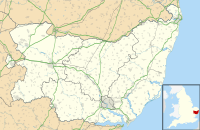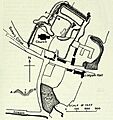Lidgate Castle facts for kids
Quick facts for kids Lidgate Castle |
|
|---|---|
| Lidgate, Suffolk, England | |

Lidgate Church, located against part of the castle bailey and incorporating the castle chapel
|
|
| Coordinates | 52°11′39″N 0°30′59″E / 52.1943°N 0.5165°E |
| Type | Motte and bailey |
| Site information | |
| Condition | Earthworks remain |
Lidgate Castle is a medieval castle found in the village of Lidgate, Suffolk, England. It was built in a very unusual square shape. Today, you can still see the remains of its earthworks.
Contents
What is Lidgate Castle?
Lidgate Castle was likely built around the year 1143. This was a time in England called the Anarchy, a civil war where different groups fought for power. King Stephen of England was battling a powerful baron named Geoffrey de Mandeville. The castle might have been built to help control Mandeville's movements in the area.
How Was the Castle Built?
The castle was constructed on a natural hill. It is a special type of castle called a "motte and bailey."
- A motte is a large mound of earth, often with a tower on top.
- A bailey is a walled courtyard next to the motte, where people lived and worked.
Lidgate Castle's motte is square, which is quite rare! It measures about 20 meters (65 feet) across and is now about 2 meters (6.5 feet) high. Next to it are two flat areas that offered extra protection. The main bailey, located to the south, was guarded by a wide ditch. This ditch was 20 meters (65 feet) wide and 5 meters (16 feet) deep. There was also a tall outer bank, about 3.2 meters (10.5 feet) high, for defense.
When Was the Castle Used?
Lidgate Castle was probably left empty and unused around the 1260s. Later, in the 13th or 14th century, a church called St Mary's was built inside the castle's bailey. The main part of the church, called the nave, was likely the castle's original chapel. Over time, the southern part of the castle was removed to make space for the growing village and farming.
Today, Lidgate Castle is known as a scheduled monument. This means it is an important historical site protected by law.
Images for kids



